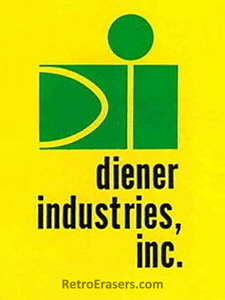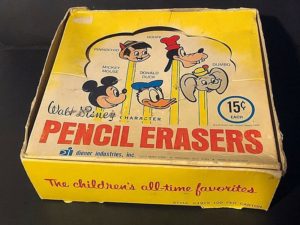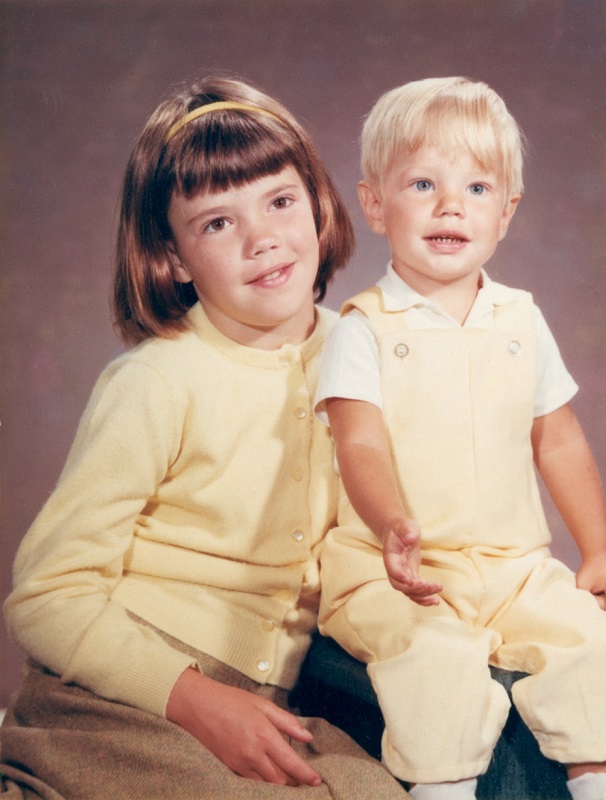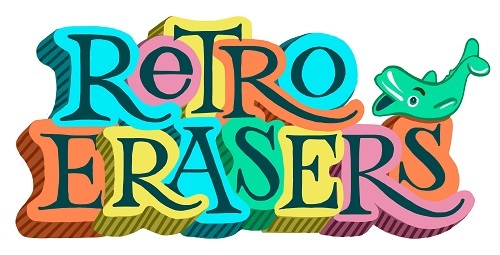A resource for vintage erasers
RetroErasers.com is a resource for vintage erasers, especially those made by Diener Industries and Concepts Inc. between 1955 and 1993.

Diener logo, 1960s
Diener Industries made soft rubbery figures as erasers, including Itty Bitty Charm Animals, Space Raiders robots and starships, cartoon characters, dinosaurs, cars, and many more.
This site was created with love by Lynne and Craig, a sister and brother who grew up playing with retro erasers in the American Midwest during the 1960s and ‘70s. It is purely a fan site, not affiliated with Diener. Lynne treasures a letter that founder William Diener wrote to her personally in 1978 in response to her request for information. He told her about the company history and added, “It is letters such as yours that are motivating factors in our effort to create exciting and unique lines, especially those that appeal to our valued customers.”
Kids and collectors love Itty Bitty rubber animals
“Itty Bitty Charm Animals” is the name Diener gave to its original and most enduring line of soft rubber animal erasers. Each character was sculpted by an artist to be a whimsical representation of a real animal found in nature. Early versions of the animals had hand-painted details to make them even more realistic and appealing. They include about 35 creatures from land and sea, farm and zoo. Many of them have human qualities, wearing hats and coats and gesturing as if they are speaking or singing. Most people called them “rubber animals,” even though they were actually made of soft plastic.
The rubber animals have a delightfully flexible quality that is unlike almost any other figurines made then or even now. Children love them for being so cute and soft. Adult collectors still prize them today, with rare ones fetching high prices. They provided fun for a whole generation of Baby-Boomer youngsters at the low price of 15 to 25 cents each. Kids saved their pennies to buy them one at a time. Families passed them on from generation to generation.
Rubber animals were often sold in open cardboard or plastic bins with header cards, allowing the shopper to pick out whichever characters they wanted. Doctors and dentists also gave them to their young patients to ease the stress of medical visits. Lucky children received them at school, in cereal boxes, in restaurants and from other businesses. They came in a variety of colors and were usually about 1-3/4 inches tall — just right for a child’s hand. Considered highly collectible, they show up now at online auction sites as “vintage erasers” or “antique erasers.”
Diener and Disney joined forces
Diener Industries was founded by in 1955 by William Maurice Diener (Feb. 5, 1909 – May 19, 1997), a World War II veteran with a degree in chemical engineering. At first the firm was called Plastic Foam Seal Co., and the earliest ads and packaging use that name. His expertise was polyurethane, a plastic material that had just became commercially available in the early 1950s. News reports describe Diener as a scientific genius who became disillusioned with the defense industry and escaped into toy making. He wanted to make toys, not bombs.

Diener logo, 1970s
During its history Diener Industries operated out of various locations in southern California. Its primary headquarters was in Chatsworth, but at various times it also had offices and/or factories in Van Nuys, Sepulveda and North Hollywood. They had sold 1 billon erasers by 1983, and were reportedly producing 3 million per month in 1991.
Disneyland and Diener Industries were both founded in southern California in 1955, and that is no coincidence. News reports say that Walt Disney called Diener to discuss why his souvenir pencils weren’t selling at his new theme park. Diener suggested making pencil-topper erasers shaped like popular Disney characters such as Mickey Mouse and Pluto. These became Diener’s first erasers. They were such a hit that Disney had trouble finding enough pencils to keep up with demand. Soon Diener engaged someone whom he described as “one of America’s most outstanding sculptors” (possibly Ginnie Neill) to design his company’s own original line of animal-themed erasers. He worked with Concepts Inc. for toy design, as evidenced by the Concepts logo in the 1966 Diener catalog.

A vintage box of Disney erasers by Diener. Photo courtesy of Buttamin1.
These Itty Bitty Charm Animals and other character lines by Diener were extremely popular across America, with a reported 1 million units being manufactured every week during the late 1970s. They were shipped to many parts of the world and even became popular in France as “Esso Glups” giveaways at Esso gas stations.
The early versions of these animals did not have any manufacturer or copyright information molded into the eraser, but they are presumed to have been made by Diener Industries as no other company appears to have been making these distinct characters at that time. In fact, Diener was probably the first company to make eraser figurines.
Their “secret process” involved pouring molten vinyl into huge steel centrifuges for spin-casting, a cutting-edge technology at the time. Early packaging described them as “pliable foam erasers” or boasted that they were “shatter-proof, safe, non-toxic, pliable plastic foam.”
Space Raiders, dinosaurs and more
At some point in the late 1960s or early 1970s, Diener decided to expand its line of products to include a wide variety of subjects ranging from automobiles to mythological creatures. The Space Raiders line of robots and spacecraft became Diener’s most popular line shortly after its introduction in 1978. When McDonald’s fast-food restaurants introduced Happy Meals for kids in 1979, Space Raiders and circus animals were among the first toys to be included as prizes. Diener also began marketing some of the Itty Bitty animals in larger sets that were themed around holidays like Christmas and Easter. These were packaged in a variety of ways, including open bins, blister cards, boxed set and clear polyethylene bags.
Many of these newer sets were more realistic than the original Itty Bitty Charm Animals, and marketed as having an educational value. During this era, the composition of the material used to make the erasers also changed, becoming noticeably harder in the later sets of figures. There were also a number of licensed character tie-ins, some of which were given away as premiums at McDonalds and other retailers.
As foreign competition arose, Diener Industries was ahead of its time in outsourcing some new product lines, but its signature erasers were always made in America. Sales began to flatten around 1980, when Diener sought advice from marketing consultant Murray Garrett (April 27, 1926 – Jan. 2, 2020). He helped expand Diener’s product line and purchased the whole company, taking the helm when Diener retired in 1982. Garrett was a colorful character and successful paparazzi who photographed Marilyn Monroe, Frank Sinatra and many other celebrities. But he happily left Hollywood behind and reveled in his second career as the exuberant “eraser king.”
Under his leadership, Diener had its last big success in 1993 by creating a line of new dinosaur erasers to ride the wave of popularity caused by the blockbuster movie “Jurassic Park.” That same year Diener Industries was sold to WinCraft Inc., a promotional products maker based in Winona, Minnesota, with Garrett remaining as president. Production continues to the present in limited form, but the heyday of Diener was over.
Special thanks
RetroErasers.com is grateful to Margaret for sharing her vast knowledge about novelty erasers and sending us treasures from her own eraser collection.
Sources
Personal letter from William Diener to Lynne, dated Aug. 21, 1978.
“Eraser King Cleans Up on Novelties,” Los Angeles Times, Dec. 12, 1982.
“Witch Erasers Are a Scream,” Los Angeles Times, Oct. 16, 1988.
“Terminating errors, promoting images: he’s . . . Eraserman,” Los Angeles Business Journal, Aug. 19, 1991.
“Dinosaurs thriving: Long-extinct creatures becoming monsters of merchandising” by New York Times News Service, Lawrence Journal-World, March 26, 1993.
Diener catalogs, 1966 and 1977
© RetroErasers.com

Lynne and Craig, 1966
